8 Mistakes You're Making That Are Killing Your Christmas Tree, Experts Say
From where you buy your tree to how you decorate it, these are the reasons it's dying.
Unless you're going for that Charlie Brown look, chances are you want a Christmas tree that's large, luscious, smells great, and lasts all holiday season. But all too often, the evergreen that we tie to the roof of our car quickly ends up dry, brown, and nearly dead not long after we get it home. Fortunately, plant and home improvement experts say there are some simple things you can avoid doing to get the conifer of your dreams. Keep reading to learn about the biggest mistakes you're making that are killing your Christmas tree.
READ THIS NEXT: Never Buy a Christmas Tree That Feels Like This, Experts Warn.
1
Not buying a fresh-cut tree
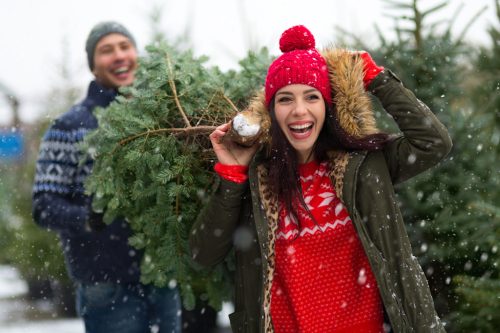
The absolute best way to get a Christmas tree is to cut it down yourself at a farm (or have a tree vendor cut it for you if you're not comfortable with the saw). "This ensures you'll start with the freshest possible tree," says Lindsay Pangborn, the gardening expert for Bloomscape.
If you must go for a pre-cut tree, Pangborn recommends finding one that was cut within the last few days. Of course, many tree vendors may not have this info for you. In this case, "try to find one with bright green needles that are slightly sticky to the touch," advises Jen Stark, founder of the blog Happy DIY Home. "If you're able to test it out, give the tree a gentle shake and see how many needles fall off. If too many come off, then the tree is likely not fresh and will not last very long."
2
Skipping the prep work when you get your tree home
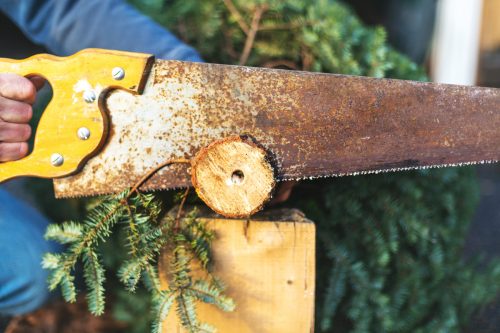
For most of us, the hard part is tying the tree to the top of the car and lugging it into the house, but the work doesn't stop there.
"A tree that has been cut for more than several hours will need to have the bottom half-inch of the trunk cut off before you place it in a tree stand with water," says Vladan Nikolic, founder of indoor plant blog Mr. Houseplant. "The reason for this is, once a tree is cut and exposed to air, after some time the cells on the cut become unable to take up water. Once you re-cut the trunk, it's able to take up water again."
Then, according to Pangborn, "You'll want to immediately place it in water to prevent the cut from sealing over with the tree's sap, which will prevent the uptake of water."
It's also a good idea to pre-adjust the temperature of the room in which you'll be putting the tree. "Christmas trees can suffer from shock when they're moved from chilly outside temperatures into a warm house, so turn down the heating to help your tree adjust to its new environment," explains Kelly Martin, founder of Urban Garden Gal.
3
Using the wrong size stand
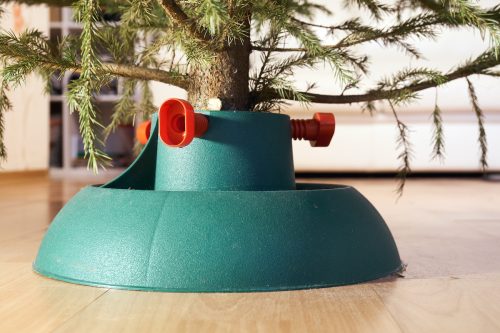
The height of your tree and its trunk thickness should dictate the stand you're using. If the stand is too small, you might need to shave off part of the trunk to get it to fit, which the National Christmas Tree Association (NCTA) says is a big no-no: "The outer layers of wood are the most efficient in taking up water and should not be removed."
For more holiday advice delivered straight to your inbox, sign up for our daily newsletter.
4
Not adequately watering your tree
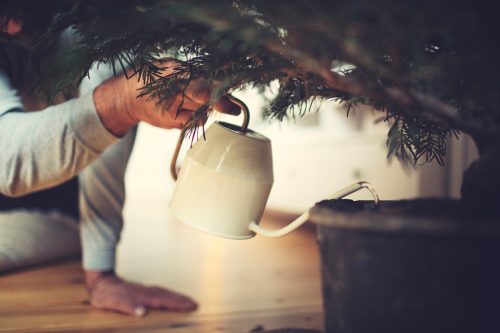
Of course, you know your Christmas tree needs water, but you may not know how much it needs. According to the NCTA, the general rule is one quart per inch of stem diameter (your stand should have the capacity to hold this).
The group also says to check the stand once a day to make sure the water hasn't gone below the tree's base. "With many stands, there can still be water in the stand even though the base of the tree is no longer submerged in water," they explain.
But as Pangborn notes, during the first week, your tree may be extra thirsty and need its water topped off once or twice a day. "If the water drops below the trunk, there's a good chance the sap will seal over the end and your tree will dry out more quickly," she explains.
Martin says that using warm water will keep your tree fresher for longer. "The warm water stops the sap hardening, so it's easier for the tree to absorb water," she adds.
And remember that all you need is plain-old tap water to keep your tree healthy. "Nowadays, additives like honey and lemon juice are being marketed as 'life preservers' for Christmas trees," notes Brian Campbell, founder at WaterFilterGuru. "However, there are no scientific results to back these claims."
"If at any point the tree runs out of water, the wound on the bottom of the trunk will start healing and the tree will be unable to absorb water," says Nikolic, who adds that, in this case, you'll need to re-cut a half-inch off the bottom of the trunk.
5
Putting your tree in a hot room or next to a heater

Of all the mistakes experts commonly see, allowing heat to dry it out is the top way people kill their Christmas trees. "Trees lose water through pores called stomata located on the underside of leaves," explains Kevin Huang, founder and CEO of Ambient Home. "In evergreens, the stomata are deep within the pine needle, so they don't quickly lose water, [but] when the air is very dry, they will still lose water faster than usual."
Usually, this occurs because trees are placed next to heating elements like fireplaces or radiators. But it can also happen if the room is too hot or gets an above-average amount of direct sunlight. If the latter is the issue, Martin suggests closing the curtains when the sun is at its peak. And Kevin Busch, vice president of operations for Mr. Handyman, says "it's also important to keep your thermostat at a temperature of 69 degrees or less to keep your tree happy."
Using a humidifier to add moisture back into the room is a good way to counteract these effects, according to Huang. You can also use a spray bottle to mist the branches directly.
6
Putting your tree near vents
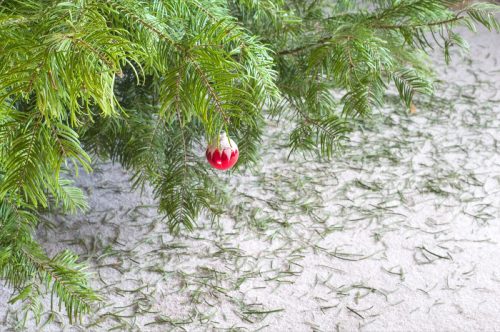
Regardless of whether they're blowing out hot or cool air, vents will cause your tree to dry out by pulling moisture from the needles, says Pangborn.
"If it's unavoidable, keep an extra-close eye on the water level in the reservoir because the tree will likely use up water more quickly," she advises.
READ THIS NEXT: This Is the Worst Time to Buy a Christmas Tree, Experts Say.
7
Over-decorating or using heavy ornaments
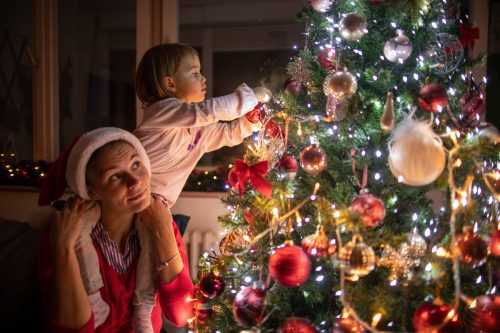
"Avoid overloading your tree with too many decorations, as this can cause too much weight and strain on the branches," notes Kamil Kowalski, president of LimakWay Remodeling.
If you do have heavier ornaments, place them on the lower branches to avoid the tree becoming top-heavy and potentially toppling over.
8
Using the wrong (or too many) lights

Some Christmas lights, especially older versions, give off a lot of heat, and we know what heat does to a tree. Perhaps the safest bet is to use battery-powered LED lights "that have no flame risk associated with them," notes Stark. Many of these types of lights can also be set to a timer, which makes turning them off before bed extra convenient.
You also never want to use too many lights, as that becomes a fire hazard. "The basic rule of thumb is using one strand of lights for each foot of your Christmas tree," explains Robert Johnson, the senior director for merchandising at Coast Appliances. "One average strand has 150 to 200 lights. For instance, you can use six average strands or 600 to 1200 lights for a six-foot Christmas tree." However, it's always advisable to read the safety instructions on any lights you purchase.
Another piece of advice Johnson shares to reduce the risk of fire is not to use the same electrical socket that's being used for a television or other home appliances, as it can cause a power overload.






















